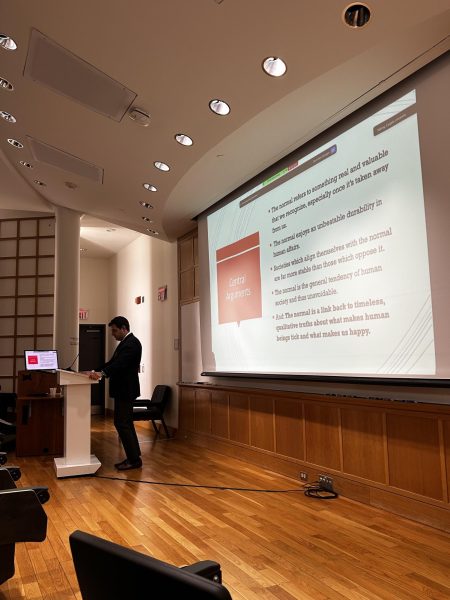Colgate’s Sustainability and Climate Action Plan Will Meet Goal
In September of 2011, Colgate set its goal of becoming carbon neutral by 2019, the 200th anniversary of the university’s founding. The plan outlined 27 on-campus projects in Colgate’s Sustainability and Climate Action Plan, which was submitted to the American College and University Presidents’ Climate Commitment.
Director of Sustainability John Pumilio said that the school is still on target to achieving carbon neutrality by 2019. The university reaffirmed its commitment a few weeks ago when the Board of Trustees approved the updated Strategic and Campus Master Plan explicitly mentioning climate action work.
“Regarding our overall emissions, we are doing better than what we anticipated. Since our baseline in 2009, we have reduced our campus emissions by 20 percent,” Pumilio said.
The plan is also fiscally responsible. The one-time implementation cost of the plan was set at $8.1 million, with $7.3 million allotted for an ambitious heating plant upgrade project. In 2013, the university reduced its operating budget by about $500,000, including a savings of over $100,000 off the water bill alone. The completion of the heating plant upgrade by the fall of 2014 will see an additional savings that will put the school on track to meet its 2015 goals.
The Sustainability Council, which defines its mission as to “join together to promote greater awareness around issues of sustainability and work to ensure that Colgate’s campus and land holdings thrive” has led the charge in a numerous and diverse green initiatives. Colgate’s wood fired boiler processes around 20,000 tons of local and sustainably collected wood chips each year. This supplies 75 percent of the campus’ heat and hot water needs and saves the school over one million gallons of fuel oil each year.
In 2012, the university planted the Colgate University Forest in the Patagonia Sur Nature Reserve in southern Chile, consisting of 225,000 native trees on 428 acres of land. The agreement includes the purchase of 5,000 tons of carbon offsets per year for 15 years. The Green Bike program provides students on campus with rental bicycles on a semester-long basis. The school’s half-acre community garden was made possible by a gift from the class of 2010, and food from the garden can be found in Frank Dining Hall. Newly installed renewable solar energy panels on the side of 100 Broad Street (Creative Arts House) eliminates the use of 900 gallons of fuel oil while reducing heating costs.
Despite these prominent efforts, faculty and students involved in environmental efforts emphasize the continued need to spread awareness about sustainability.
“Sustainability is still a niche program at Colgate. There are many students and departments around campus that are somewhat unfamiliar with sustainability, why it is important and the many benefits it can bring once embraced,” Pumilio said.
Senior Kathryn Bacher and sophomore Gillian Fisher are members of the Green Raiders, a group of student interns in the Office of Sustainability who work to promote eco-friendly efforts at Colgate. Bacher and Fisher are optimistic about the positive changes going on around campus, but agree that the student body can be doing more to support green initiatives.
“I think the greatest accomplishment I’ve seen thus far has been getting sustainability into the Campus Master Plan. The fact that the administration has made a commitment to recognize and promote sustainability in the upcoming years is a huge step in the right direction,” Fisher said.
“Our role is also to try and shift a paradigm and have students incorporate sustainability into all aspects of their daily lives. We’d like to make it something that is not an afterthought but rather second nature,” Bacher said. “I think as a community we could be doing more to better educate the student body about climate change and what individuals can personally do on campus to reduce their
ecological footprints.”
“The best thing we can do to continue addressing sustainability fully at Colgate is to recognize that the ‘thinking and doing’ of sustainability is best done collectively and openly across the entire institution with the long-term interests of the Colgate community in mind,” Sustainability Council Chair and Associate Professor of Geography Jessica Graybill said. “This takes time and effort across multiple constituencies, and we could do better at building bridges across people, time and space to address these issues.”
“I think in order for us to truly become a sustainable community, sustainability needs to become something that everyone at Colgate participates in and embodies,” Program Assistant for Environmental Studies Steve Dickinson ’13 said.
Dickinson added that Colgate’s green initiatives are faring extremely well in comparison to those of other similarly-sized colleges and universities.
“We have one of the most aggressive carbon neutrality dates in the country, especially compared to our peer schools,” Dickinson said.
While admitting that much work remains to be done, all parties see the school’s carbon neutral goal and environmental projects as a positive step to revamp the campus’ attitudetoward sustainability.
“Having sustainability as a salient goal in our Strategic and Master Plan updates is a significant statement by the University and gives Colgate’s coalition of the willing an opportunity to lift sustainability to new heights, to be an overarching framework for the way we teach, operate and make
decisions,” Pumilio said.
“Once this happens, Colgate will begin to realize the true benefits of sustainability as it promises to enhance our liberal arts education, build increased resiliency and operational efficiency, reduce operating budgets, attract and retain students and faculty, and create new pathways for alumni who want to contribute to Colgate’s future in a positive way,” he said.
Contact Colin Sheridan at csheridan@colgate.edu.




